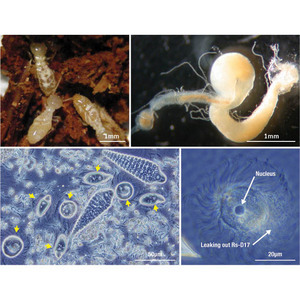Aug. 1, 2008 Research Highlight Biology
Bugs helping bugs
Scientists get their first glimpse into the workings of the complex bacterial community residing within the termite gut
 Figure 1: Rs-D17, a gut microbe isolated from the termite species Reticulitermes speratus (top left). Within the gut (top right) of the termite is a thriving ecosystem of microbial species (lower left). The Rs-D17 bacterium can be seen leaking out of a gut protist cell in which it resides (lower right). Reproduced from Ref. 1 © 2008 National Academy of Sciences of the USA
Figure 1: Rs-D17, a gut microbe isolated from the termite species Reticulitermes speratus (top left). Within the gut (top right) of the termite is a thriving ecosystem of microbial species (lower left). The Rs-D17 bacterium can be seen leaking out of a gut protist cell in which it resides (lower right). Reproduced from Ref. 1 © 2008 National Academy of Sciences of the USA
Left unchecked, a band of termites can eat their way through a house, but they can’t do it alone. Within every termite is a thriving ecosystem of bacteria that maintain an essential symbiotic relationship with their hosts, taking shelter within the insect’s gut and contributing to its survival by various means, including facilitating the digestion of plant matter.
Little is known about these symbiont species, as these bacteria have proven virtually impossible to cultivate in the laboratory and thus difficult to characterize in detail. “One termite gut harbors several hundred species of microbes,” explains Yuichi Hongoh, a postdoctoral fellow in Moriya Ohkuma’s research group at RIKEN’s Advanced Science Institute in Wako, “and it is not realistic to collect a large enough amount of a specific species to analyze with general methodologies.”
Fortunately, recent years have seen the development of new tools for obtaining detailed genomic sequence information from limited sample quantities and Hongoh, in partnership with the RIKEN Bioinformatics And Systems Engineering division (formerly the RIKEN Genomic Sciences Center), in Yokohama, was able to take advantage of these new amplification and sequencing methods to finally assemble the first comprehensive genomic sequence from a termite gut symbiont species1.
The team analyzed Rs-D17 (Fig. 1), a representative species that is thought to account for approximately 4% of all termite gut bacteria. The analysis revealed that the Rs-D17 genome consists of a single chromosome containing 761 putative protein-coding genes, as well as several smaller non-chromosomal DNA molecules.
The researchers were surprised to find that a large percentage (>15%) of the genes identified were actually pseudogenes, non-functional evolutionary descendants of known genes. Although these pseudogenes no longer generate protein, comparative analysis of the genes lost or maintained by Rs-D17 yielded some valuable hints about how the bacterium evolved to adapt to its host environment over time.
In general, Rs-D17 appears to have sacrificed its regulatory and cellular defense mechanisms in favor of maintaining robust pathways for synthesizing organic molecules required by the termite. “This indicates that this bacterium has been ‘domesticated’ by the host like an organelle, which synthesizes the nitrogen compounds critically deficient in wood food material,” says Hongoh.
He indicates that the team is now looking to extend their strategy to assemble genomic maps for additional symbiont species, in the hope of clarifying the complex relationships between the various members of this gut ecosystem. “By combining these data,” concludes Hongoh, “our understanding of termite gut symbiosis will be greatly enhanced.”
References
- 1. Hongoh, Y., Sharma, V.K., Prakash, T., Noda, S., Taylor, T.D., Kudo, T., Sakaki, Y., Toyoda, A., Hattori, M. & Ohkuma, M. Complete genome of the uncultured Termite Group 1 bacteria in a single host protist cell. Proceedings of the National Academy of Sciences USA 105, 5555–5560 (2008). doi: 10.1073/pnas.0801389105
